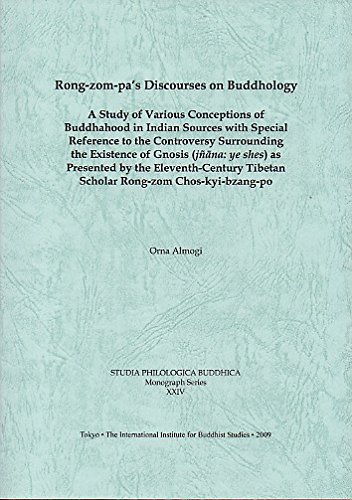- Preface13
- Chapter 1: Rong-zoin-pa's Discussion of the Controversy Surrounding the
Constituents of Buddhahood: An Overview23- 1. Introductory Remarks23
- 2. Various Positions regarding the Constituents of Buddhahood25
- 3. The Conceptions of Buddhahood Contained in Various Scriptural
Systems27 - 4. The Buddhist Doxographical Systems and Schools as the Basis of
the Various Positions33- A. Three Incorrect Positions regarding the Substratum of Appearances34
- (i) Undisputed (rtsod gzhi med pa) Positions35
- (ii) Disputed (rtsod gzhi beas pa) Positions36
- B. The Fourth and Correct Position regarding the Substratum of
Appearances37
- A. Three Incorrect Positions regarding the Substratum of Appearances34
- 5. Discussions of the Issue Found in Other Works of Rong-zom-pa38
- 6. Concluding Remarks43
- Chapter 2: Buddhology in Its Historical and Philosophical Context:
An Overview45- 1. Introductory Remarks45
- 2. Non-Mahayana Buddhology47
- A. Nirvāṇa without Remains and the Indirect Activities of the
Buddha in the World47 - B. The Notions of Transcendental and Multiple Buddhas and
Their Fields51
- A. Nirvāṇa without Remains and the Indirect Activities of the
- 3. Non-Tantric Mahāyāna Buddhology53
- A. The True Nature of the World as Nirvāṇa and the Inconceivability of
Buddhahood56 - B. Buddhahood as Defined by Qualities and the Notion of Unfixed
Nirvāṇa57 - C. The Theory of the Three Kāyas61
- D. The Four Gnoses68
- E. The Notion of Bliss70
- A. The True Nature of the World as Nirvāṇa and the Inconceivability of
- 4. Tantric Buddhology76
- A. Mantras, Vidyās, and Dhāraṇīs81
- B. Mudrās88
- C. Manifold Expressions of Buddhahood106
- (i) Multiple Bodies108
- (ii) Multiple Gnoses114
- (iii) Multiple Buddha Families119
- D. The Notion of Ādibuddha125
- E. Wrathful Manifestations128
- F. Maṇḍalas130
- G. The Notion of Great Bliss134
- 5. Concluding Remarks137
- Chapter 3: The Controversy Surrounding the Existence of Gnosis at
the Stage of a Buddha139- 1. Introductory Remarks139
- 2. The Problem of Ascribing a Mental Element to the Absolute139
- 3. The Mental Element of the Absolute and Yogācāra Theories of
Knowledge142 - 4. A Buddha's Knowledge (jñāna: ye shes): A Brief Discussion of
the Key Terms160- A. On the Tibetan Term ye shes160
- B. Non-conceptual Gnosis and Pure Mundane Gnosis163
- 5. Unfixed Nirvāṇa: The Absolute and Its Activity in the World171
- 6. The Various Positions and Their Proponents176
- A. Indian Authors177
- (i) Proponents of the Purified Dharmadhātu as the Sole
Constituent of Buddhahood (Position 1)177- (a) *Madhyamaka-Siṃha177
- (b) Mañjuśrīmitra178
- (c) Atiśa179
- (d) Candraharipāda180
- (e) Bhavya180
- (ii) Proponents of the Existence of the Purified Dharmadhiitu and
Non-Conceptual Gnosis (Position 2)181- (a) Nāgamitra and Jñānacandra181
- (b) Dharmamitra182
- (iii) Proponents of the Existence of Pure Mundane
Gnosis (Positions 3-6)184- (a) Śrīgupta184
- (i) Proponents of the Purified Dharmadhātu as the Sole
- B. Tibetan Authors up until the Eleventh or Early Twelfth Century185
- (a) Ye-shes-sde185
- (b) Gro-lung-pa186
- (c) sGam-po-pa186
- A. Indian Authors177
- 7. Concluding Remarks187
- Chapter 4: Rong-zom-pa's Position on Whether Gnosis Exists at the
Stage of a Buddha189- 1. Introductory Remarks189
- 2. Rong-zom-pa's View regarding the Existence of Gnosis at the
Stage of a Buddha as Addressed by Mi-pham193- A. The Main Points of Mi-pham's Argumentation193
- B. Mi-pham's Discussion: A Translation199
- 3. Self-occurring Gnosis206
- A. Occurrences of the Term in Indian Sources206
- B. Rong-zom-pa on Self-occurring Gnosis215
- 4. Rong-zom-pa on How the Buddhas Act220
- 5. Rong-zom-pa's Madhyamaka Affiliation226
- 6. Concluding Remarks232
- A Note on the Annotated Translations235
- The Sangs rgyas kyi sa chen mo237
- 1. An Outline of the Text237
- 2. An Annotated Translation239
- The Discussion in the dKon cog 'grel 277
1. An Outline of the Text .................................................................... 277 2. An Annotated Translation .............................................................. 278 Works by Indian Authors ............................................................................. 299 1. Proponents of the Purified DharmadhiJtu as the Sole Constituent of Buddhahood .................................................... 299 A. *Madhyamaka-SiI]1ha's Dr:ftivibhiJga .................................. 299 B. MafijusrImitra's BodhicittabhiJvaniJnirdesa ......................... 306 C. AtiSa's Ekasmrtyupadda ..................................................... 310 D. Candraharipada's RatnamiJliJ ............................................... 311 E. Bhavya' s Madhyamakap'radfpa ......................... ................... 315 2. Proponents of the Existence of the Purified DharmadhiJtu and Non-Conceptual Gnosis ........................................................... 319 A. Nagamitra's KiiyatrayiJvatiJramukha and lfianacandra's Commentary, the Kiiyatrayavrtti .......................................... 319


